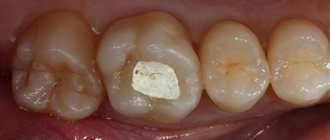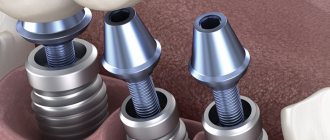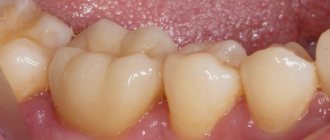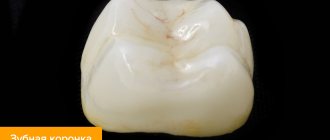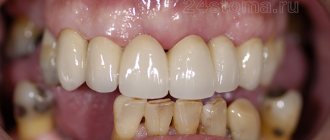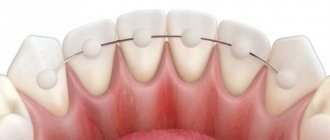Crown materials
Temporary crowns can be made from a variety of materials depending on the patient's budget and desired result. The most commonly used materials are plastic and special composites. These materials are sufficiently durable and relatively inexpensive, which is great for short-term wear. Of course, if the patient wishes, the crown can also be ceramic, metal-ceramic, or made of durable zirconium dioxide.
A distinctive feature of plastic products is that they tend to change their original shade due to exposure to food coloring, smoking, etc. Also, plastic is not able to withstand strong pressure during chewing, as a result, chips, cracks may appear, and the crown may even fall out. Due to the porous surface, pathogenic microorganisms can penetrate into the product.
If for some reason plastic is not suitable for the patient or he is allergic to this material, then the doctor may recommend the use of a composite, for example, acrylic. Such crowns are made directly in the patient’s mouth by layer-by-layer application and fixation using a special lamp.
Kinds
To select adhesive for crowns, you can consult your dentist. However, in this matter, the individual characteristics of the body play an important role, so even taking into account the recommendations, you may need to try several different options and settle on the most suitable one.
Causes of pain under the crown
A tooth under a denture can hurt both due to unprofessional work of the dentist, and due to a piece of instrument getting into the canal.
There are three types of product available, which differ in consistency:
- viscous;
- medium viscosity
- liquid.
The last type of glue consumes more than others, but it is most often chosen by people who have recently undergone the procedure of installing dental crowns. This is due to its ease of use. However, gradually, a person adapts to more viscous compositions, as they dry faster.
Why can our articles be trusted?
We make health information clear, accessible and relevant.
- All articles are checked by practicing doctors.
- We take scientific literature and the latest research as a basis.
- We publish detailed articles that answer all questions.
Any prosthesis, even a small one, causes discomfort in a person; in addition, it is capable of changing taste perception at first. To shorten the period of adaptation, it is not recommended to immediately use products that contain fragrances.
Manufacturing
Crowns for temporary use are made using two methods: direct and indirect. In the first case, all manipulations are carried out within the walls of a dental clinic, and in the second - in a dental laboratory, where experienced professionals work. You can also purchase ready-made crowns, which can simply be fixed in the mouth using a fixing compound.
Composite dentures are usually installed at the front of the smile; this material allows for maximum attractiveness. The direct manufacturing method involves preliminary taking an impression from the patient’s jaw. To do this, the tooth is prepared and an adhesive-filled impression is attached to it. After taking an impression, the patient receives a finished plastic structure, securely fixed in the mouth. All that remains is to carry out the polishing and the patient can go home; the whole procedure does not take more than 2 hours.
Indirect method: first, the tooth is prepared and impressions are made. These impressions are sent to a laboratory where a temporary prosthesis is produced within a few days. In this case, the person will need to visit the dental clinic at least twice; at the last visit, the prosthesis will be installed.
What is the function of glue?
After examination and during the process of grinding the tooth, the orthopedist decides which crown is best to install: removable or permanent, restorative or supporting. The patient is also asked to choose a construction material; it can be metal, metal-ceramics, plastic, or a combined composition.
To fix a permanent structure, a long-term and durable cementing agent is required. It tightly, hermetically holds the prosthesis in place.
Removable crowns require more troublesome care and the patient requires temporary cement to hold them on the tooth surface. You can purchase a similar adhesive composition in the pharmacy department.
What to do if a tooth has rotted under the crown
Tooth decay under the crown is a complication caused by prolonged use of the prosthesis or its improper hygienic care.
There are several types of glue that not only hold crowns and dentures in place, but also have additional effects:
- retain moisture without absorbing it (a similar product is recommended for patients with increased salivation);
- do not allow pathogenic bacteria to pass through;
- make your breath fresh - if the glue contains flavoring additives.
The fixed structure is fixed once, so composite cement is used, which provides a rigid connection for a long period. Regardless of the crown material, they are attached to the same fastening compound.
Wearing period
There is no point in wearing temporary crowns for a long time; they are usually used until the time comes to install permanent structures. On average, this is no more than two weeks, but in complex cases it may take a little longer. In any case, the attending physician will definitely orient his patient regarding the timing of treatment.
Of course, if desired, the patient can wear temporary dentures for several months. But over time, chips may appear on them, and they may change the original shade. A temporary crown helps to quickly get used to a permanent prosthesis; as a result, a person does not feel discomfort and practically does not feel the presence of a foreign object in the mouth.
The cost of such crowns will largely depend on the material used by the master, as well as on the manufacturing method. The direct method allows for significant savings; ready-made dentures also cost less. In this case, you will have to choose: high quality and aesthetic component or low cost.
How to remove temporary crowns
The crown removal procedure must be performed in a doctor's office using special dental equipment to safely remove the denture and preserve the ground tooth. You can remove the damaged crown yourself if necessary. Over time, the cement on which the temporary prosthesis is attached loosens, allowing the crown to be removed quickly and easily. If the crown has slipped or shifted (this rarely happens) and it is impossible to remove the prosthesis completely on your own, then consult a doctor to return the structure to the tooth.
How to extend the period of use
In order for the crown to last as long as possible, it is important to minimize the level of chewing load on a particular tooth. In this case, the load should be minimal not only on one tooth, but also on the entire jaw on the side where the temporary prosthesis is installed. You should also avoid certain foods: chewing gum, toffees, chocolate, nuts, hard vegetables, etc.
It is also important to pay enough attention to oral hygiene. Brushing should be done using a soft toothbrush and not applying too much pressure. You need to use dental floss with extreme caution; you can only pull it horizontally and only at one end.
A well-made temporary crown made of plastic or composite can last up to six months. If you follow all the dentist’s recommendations, quit smoking and certain products, it will not only restore the functional properties of the dentition, but also preserve the aesthetics of your smile.
previous post
How can a dentist help me maintain dental health?
next entry
Three ways to attach crowns or dentures during implantation
- Cement - attachment to the abutment is performed using composite glue. It has good shock-absorbing properties. The most common type of fixation, which simplifies the installation of a bridge consisting of several elements.
- Screw - the crown is secured to the abutment outside the oral cavity. The resulting structure must be screwed into the implant. A technological hole is used through which a screw is screwed. To disguise it, a composite material is used.
- Telescopic - involves the use of double crowns: one is fixed to the abutment, the other is mounted into the body of the prosthesis.
Advantages and disadvantages of cement fixation
Positive points:
- There is no need to prepare an access hole. This provides better aesthetic results. The use of a cement composition for prosthetics of the frontal sections is especially justified.
- Superstructure fit correction. If implantation is carried out carelessly, cement fastening allows you to smooth out all existing flaws. Due to this, it becomes possible to perform prosthetics even with a non-optimal position of the implant.
- Primary fitting can be carried out outside the oral cavity, which increases the accuracy of attachment and eliminates inflammation.
- Lower level of weakening of the adhesion of the abutment to the implant in the long term (compared to the screw type of fastening).
- Better quality of biological functioning.
- Ease of manufacture and installation. If the implant axes diverge by more than 17 degrees, restoration with cement fastening is much easier. The technique is in many ways similar to how bridges are installed.
- No passive fit required compared to screw mounting.
- Tools and materials are cheaper.
Opinion of an orthopedic dentist : “I have been working with cement fixation for many years. This is a simple, economical method. Of course, there is a risk of being unable to control the complete cleaning of the subgingival space from excess cement. It is therefore important to follow basic guidelines regarding the level of immersion of the crown/abutment interface. With cement fastening, this figure should not exceed 0.5 mm.”
The main disadvantage is the difficulty of removing the crown, which means that later, if it is necessary to replace structural elements, you will have to make a new prosthesis. Other reasons that make dentists refuse to use:
- Precision fit cannot be achieved due to the fitting of the prosthesis under hydrostatic pressure alone.
- There is a high risk of excess glue getting deep into adjacent tissues, which can cause serious complications, including peri-implantitis. Remaining cement is difficult to clean.
- In the case of an inaccurate fit between the crown frame and the abutment, saliva may wash out the adhesive over time. Plaque and bacteria will begin to fill the resulting space.
- Low predictability of connecting metal elements compared to the screw fastening method.
In what cases is it advisable to install on cement?
- Complete, partial edentia;
- single restoration;
- angulation of implants, during which high aesthetic and functional indicators become impossible;
- several designs with non-parallel mesio-distal or vestibulo-lingual angulation;
- the patient's desire to choose this method himself.
Cement fixation is possible:
- with a height of the upper part of the abutment of 5 mm or more;
- when the height of the attached gum around the structure is at least 3-5 mm;
- if the bone wall volume around the implant neck is at least 2-2.5 mm;
- with a crown-to-body height ratio of at least 1:1.5;
- antagonist teeth are in the correct position.
